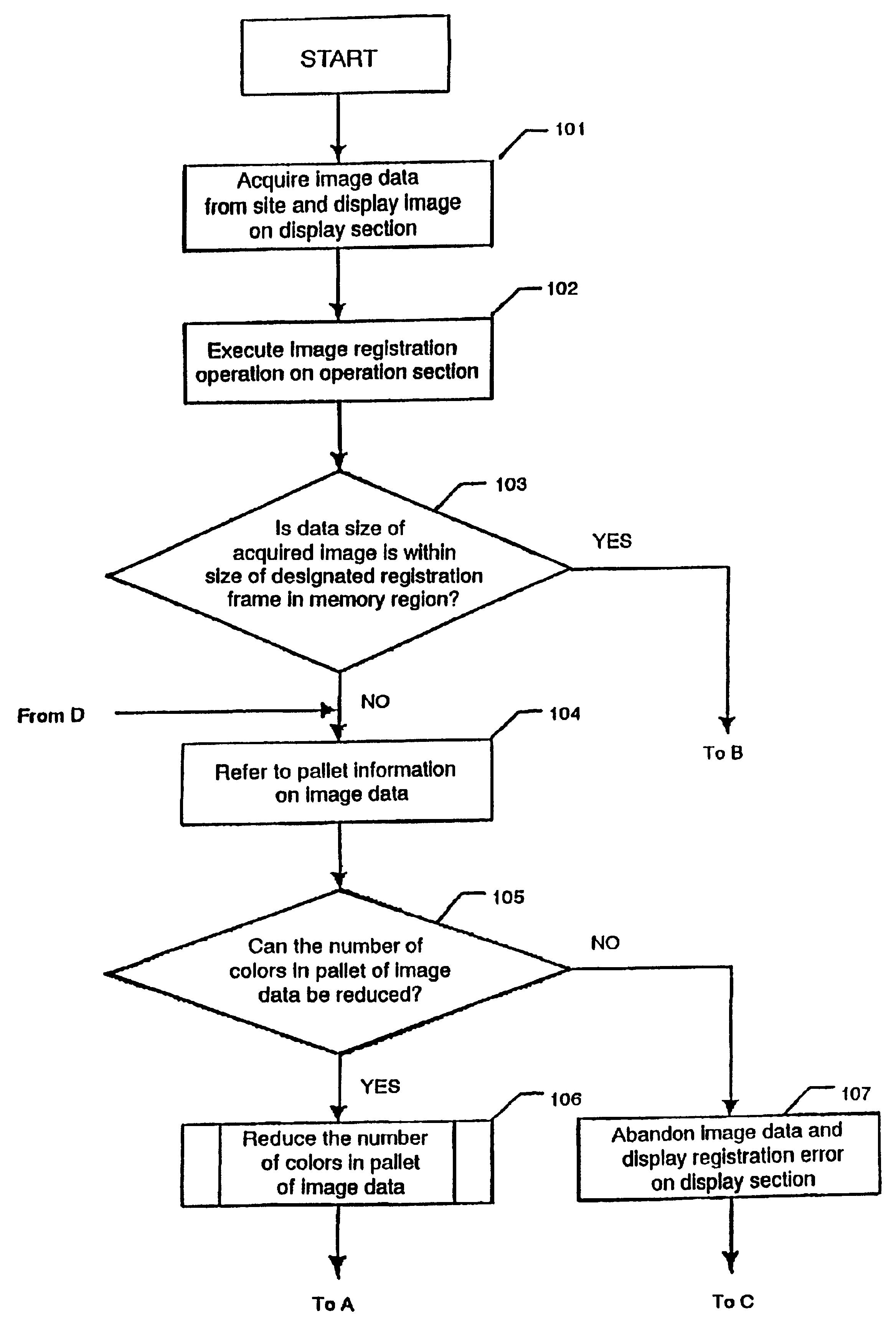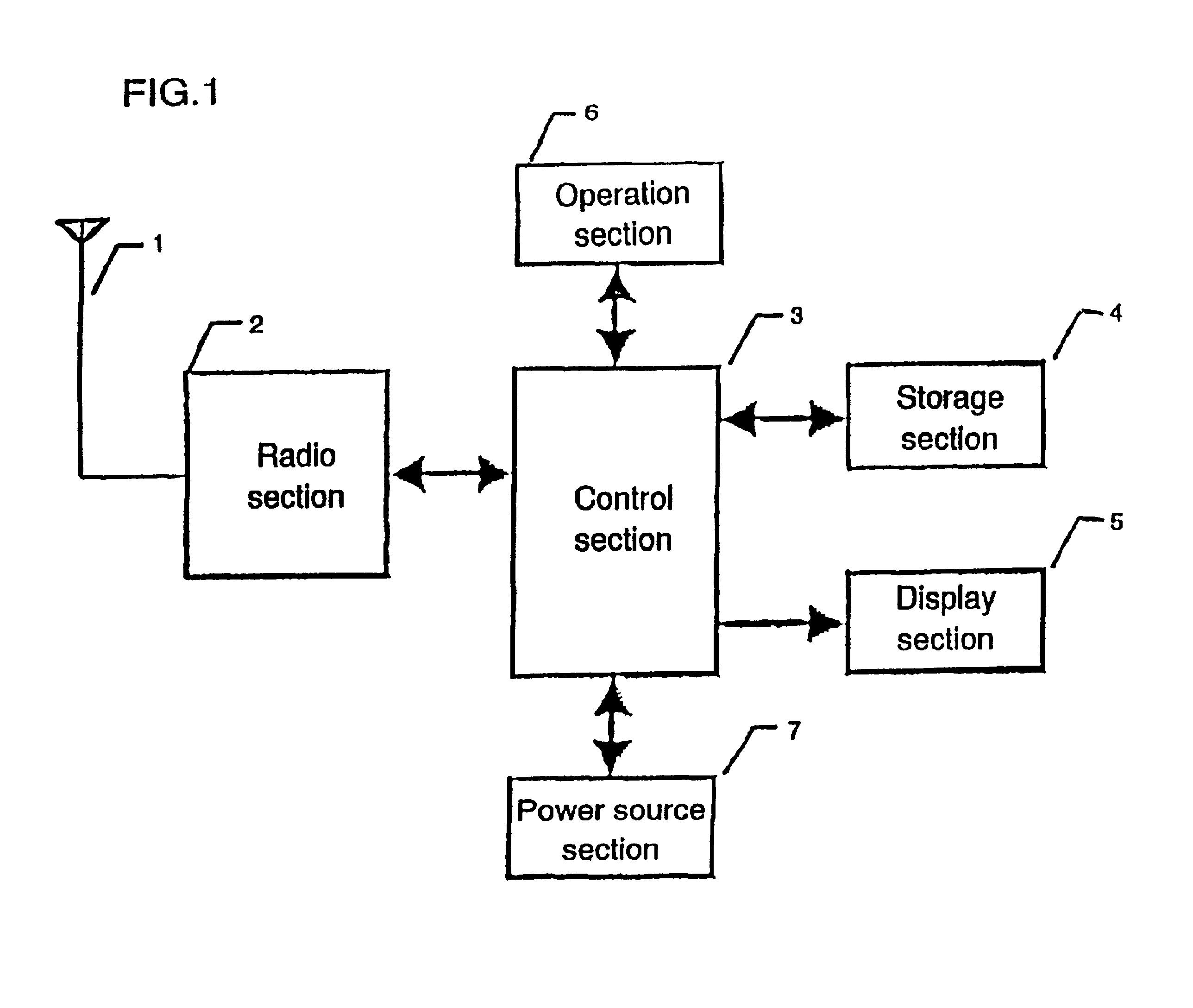Image data storage method
a storage method and image technology, applied in static indicating devices, memory adressing/allocation/relocation, instruments, etc., can solve the problems of inability to register or store all data, limited storage region secured for image data, and large storage capacity of mobile terminals, so as to increase the storage capacity of vacant regions, and reduce the number of pallet colors
- Summary
- Abstract
- Description
- Claims
- Application Information
AI Technical Summary
Benefits of technology
Problems solved by technology
Method used
Image
Examples
embodiment 1
[0030][Embodiment 1]
[0031]If image data is acquired from a site, the display section 5 displays the acquired image. If a user wants to register the acquired image, the user performs a storage operation using operation buttons prepared on the operation section 6. If the storage operation is performed, the control section 3 determines whether or not the size of the acquired image data is smaller than a designated storage frame in the memory region of the storage section 4.
[0032]FIG. 2 shows one example of the memory region management structure of the storage section 4 preferred for this mode for carrying out the present invention. The storage section 4 can register a plurality of images and a memory region allotted to one image has an equal size of a bytes.
[0033]FIG. 3 shows one example of the data constitution of image data. The image data consists of type discrimination information for discriminating an image type such as a moving image or a still image, screen size information, pal...
embodiment 2
[0046][Embodiment 2]
[0047]In the second mode for carrying out the invention, a memory is dynamically managed and already registered or stored data is also subjected to a pallet color reduction processing so as to further store all the acquired image data.
[0048]FIG. 6 shows an example of the memory constitution of a storage section 4 preferred for this mode for carrying out the invention. An entire memory M in the storage section 4 consists of a storage region R for registering or storing image data, a temporary region T for temporarily storing image data which cannot be stored in the storage region, and the other region G used for purposes other than image storage. For example, the storage region R stores image data 1, 2 and 3, and the remaining regions are vacant region V (Vacancy). In addition, the capacity of the image data 1, 2 and 3 is dependent on the quantity of data captured from an Internet website or the like and is not fixed.
[0049]FIG. 7 is a flow chart for describing an ...
embodiment 3
[0068][Embodiment 3]
[0069]In the third mode for carrying out the invention, image size (the number of vertical and horizontal dots) is added as an element for making image data small to thereby prevent color information from being considerably lost by the reduction of the number of pallet colors.
[0070]A memory management structure preferred for the third mode for carrying out the invention is the same as that shown in FIG. 2 and a memory region allotted to one image is equal among the images.
[0071]FIG. 10 is a flow chart for describing an image data storage method in the third mode for carrying out the invention. FIG. 11 follows the flow chart of FIG. 10.
[0072]First, in a step S301, when image data is acquired from a site, the acquired image is displayed on the display section 5.
[0073]Next, in a step S302, if a user wants to register the acquired image data, the user performs a storage operation using operation buttons prepared on the operation section.
[0074]Next, in a step S303, th...
PUM
 Login to View More
Login to View More Abstract
Description
Claims
Application Information
 Login to View More
Login to View More - R&D
- Intellectual Property
- Life Sciences
- Materials
- Tech Scout
- Unparalleled Data Quality
- Higher Quality Content
- 60% Fewer Hallucinations
Browse by: Latest US Patents, China's latest patents, Technical Efficacy Thesaurus, Application Domain, Technology Topic, Popular Technical Reports.
© 2025 PatSnap. All rights reserved.Legal|Privacy policy|Modern Slavery Act Transparency Statement|Sitemap|About US| Contact US: help@patsnap.com



